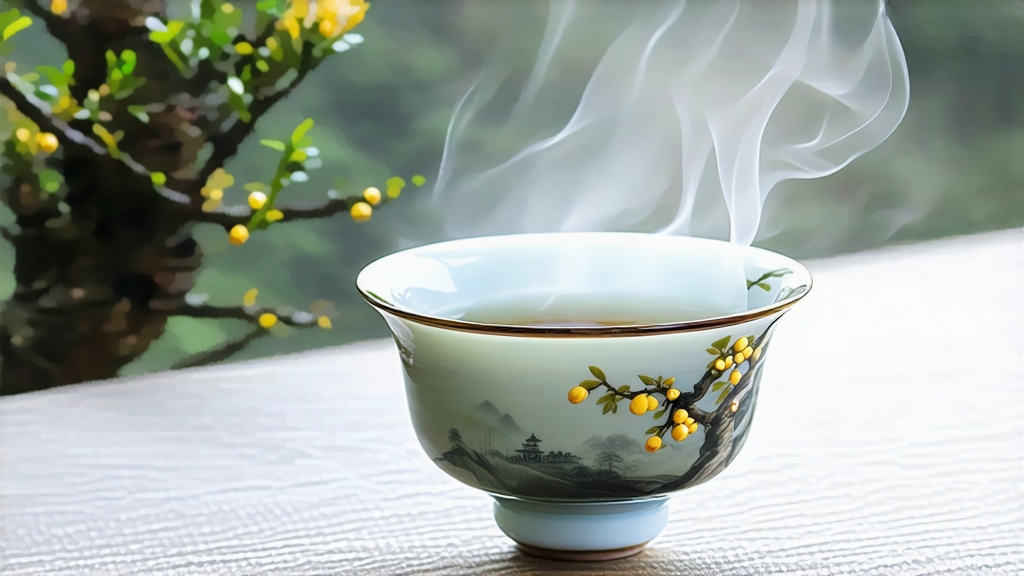
Tucked high above the Sichuan basin, where the Himalayas begin their gentle descent toward the Chengdu plain, a narrow ridge called Meng Shan has been shrouded in cloud almost three hundred days a year since the Tang dynasty. In that perpetual humidity, under canopies of evergreen and sweet-fern, gardeners once worked for emperors, coaxing a tiny spring bud into a tea so subtle that poets called it “the dew of the immortals.” Today the same bud is still plucked, still coaxed, and still carries the name Meng Ding Huang Ya—Meng Ding Yellow Bud—the most aristocratic yet least known member of China’s yellow tea family.
A STORY WRITTEN IN GOLDEN CHARACTERS
The first written record appears in 808 CE, when the Tang court chronicler Fan Chuo listed “Meng Shan stone-flower” among the nine tribute teas demanded by imperial edict. By the Song dynasty the buds were wrapped in silk, sealed with wax, and escorted by mounted couriers to Bianliang; failure to deliver before the Dragon-Boat Festival was punishable by exile. When the Ming court moved north, the tea route lengthened; caravans carried the bamboo-packed chests over plank roads suspended above the Min River, a journey so perilous that locals joked “ten horses, nine lost.” Imperial patronage ended in 1911, and Meng Ding Huang Ya retreated into monastery gardens, surviving only because Buddhist monks valued its medicinal calm. When Chinese tea historians re-discovered it in 1959, they found 1,200-year-old tea hedges still alive on the summit, their trunks as thick as a man’s thigh. A single state-run workshop was built the following year; today fewer than six families still master the full traditional process, producing perhaps 600 kg a year—less than one day’s harvest of West-Longjing.
THE MICRO-CLIMATE THAT MAKES A BUD WORTH A WEEK
Meng Shan rises 1,450 m above sea level, but its real secret is the “rain belt” created when moist monsoon air meets the cold Tibetan plateau wind. The temperature difference between day and night can exceed 15 °C, forcing the tea bush (a local Camellia sinensis var. sinensis clone known as “xiao ye zhong,” small-leaf species) to store amino acids in self-defense. The result is a bud so tender that one kilo needs 42,000 plucks, each consisting of an unopened spear less than 25 mm long picked before the Qingming festival. At this altitude photosynthesis is slow, so the bud contains only 1.8 % catechins but 6.4 % theanine—twice the level of spring-longjing—giving the liquor its trademark brothy sweetness.
THE LOST ART OF “SEALED YELLOWING”
Yellow tea is often described as “green tea with an extra step,” but the step is so delicate that a five-minute miscalculation turns the batch into expensive green tea. After picking, the buds are spread on bamboo trays for six hours of withering; moisture drops from 74 % to 68 %, just enough to soften cell walls. The first fixation follows, but at 20 °C lower than longjing: the leaves are tossed in an iron wok kept at 140 °C for exactly 180 seconds; enzymes must be stunned, not killed. While still warm they are wrapped in thick linen bundles the size of a pillow; the core temperature remains 55 °C for the next four hours, initiating non-enzymatic oxidation that turns chlorophyll into pheophytin and converts bitter catechins into softer thearubigins. This “sealed yellowing” (men huang) is repeated three times, each cycle reducing the bundle size as the leaf shrinks. Finally the leaves are dried over charcoal embers covered with a thin layer of Meng Shan clay; the clay moderates heat and imparts a trace of mineral that connoisseurs liken to wet slate. From pluck to finished tea takes seven consecutive days; during that period the master never sleeps more than two hours at a stretch, afraid that a single sour note will ruin the tribute.
SHAPE, AROMA, AND THE IMPOSSIBLE COLOR
Finished Meng Ding Huang Ya looks nothing like the fluffy “yellow bud” photos on commercial sites. The leaves are needle-thin, olive-gold, and slightly hooked like a falcon’s claw. When placed under